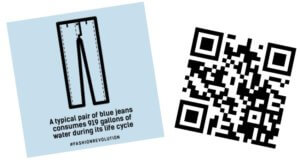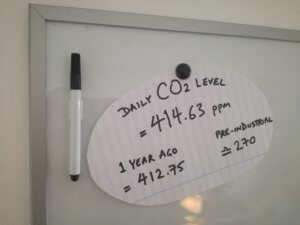This post is based on a presentation given at the Innovate conference in September 2020.
Since we came together a year and a half ago, one of the areas ELT Footprint members have been exploring is how to plan effective lessons that raise awareness of the environmental crisis and motivate learners to act. Through ideas shared in the group and courses like those run by ELTsustainable, we know how to avoid lessons that lecture or depress and how to make them relevant, personal and positive – exactly what is needed to motivate people to face up to the challenge.
But we’ve also become aware that stand-alone lessons are often impractical. Institutions, curricula and the students themselves may have expectations and demands about what is covered on the course, and if it isn’t in the book or the exam, then alas! The time just isn’t there to do it. What’s more, too often that isolated lesson on ‘The Environment’ feels like tokenism, and this half-hearted approach compartmentalises eco-awareness rather than acknowledging how the environmental crisis touches on nearly every aspect of human experience, from consumerism to family … to pastimes … to food … to fashion … to travel … to entertainment … to communication …

So while we need to push for more lesson time dedicated to the crisis with tailor-made lessons and materials, we are also learning how to integrate the key issue of our time into our day-to-day teaching. In other words, how to normalise sustainability in ELT .
As I see it, we can do this in four areas of the class experience:
• the lesson content, i.e. topics, tasks and materials.
• the classroom, i.e. sustainable practices during class time.
• the institution, i.e. how the class influences sustainability practices throughout school.
• the teacher and students’ lives outside school, i.e. sustainable habits and activism.
In this post I am focusing on the first and second areas, those of integrating issues into lessons and classroom practices. But I think it’s still important to note our potential influence on the running of the school as a whole and in our students’ personal lives away from class.
Here are ten ideas for integrating sustainability into our lessons. As far as possible, they are ideas that save teachers the stress of significantly greater planning time. So for example, you might need to replace a five-minute stage in the lesson with another five-minute stage that you have come up with. Or you add a short routine at the start of every lesson, which quickly becomes part of every lesson. This is by no means a comprehensive list and simply represents some potential ideas I have compiled. All of them require further development, so treat this post as an invitation to collaborate and continue the work of developing a sustainable methodology for ELT.
The discussion slot
Let’s say you are doing a lesson about the history of jeans. The general topic is clothes and fashion. Hardly surprising, but the text the students will read makes no mention of the environmental impact of denim manufacture, so you take a few minutes to research a few basic facts and prepare some questions for the students to work on after the reading. You simply display or dictate these questions and put students in groups or breakout rooms to discuss.

Notice that these questions …
- personalise the topic
- get students actively working on a problem
- view the environmental issue as an opportunity for whole-class community action and a problem to be solved
- call students to action
Recently I’ve toyed with the idea of creating a bank of questions to cover all the typical topics we tend to meet in course materials, exams and so on, or perhaps there’s a formula we could come up with to help teachers create good questions for this purpose. So if there’s anyone with this resource already, or who’s willing to put some time in to create one for ELT Footprint, I’d love to hear from you!
The added task
After the reading and language work, the teacher poses the following online research task:
Find out the cost to the environment of a pair of jeans. Present an action plan based on what you have learned to reduce this cost.
Even less preparation than the discussion questions, this also has the advantage of not taking up class time – it could be set as homework. What’s more, it encourages learners to find out for themselves. Our job is not to be the fount of knowledge; environmental awareness should come from the students as much as possible. By handing over the reins to them in this way, we can let them teach each other… and us, too!
The classroom decoration
Students notice changes you make to the classroom, so pin up an infographic or a QR code on the wall about the true costs of denim. Fast finishers, or anyone before or after the lesson can look at it and ask you about it.

CO2 level monitor
Common ‘decoration’ items in the classroom are things like weather posters and the date on the board, especially in the young learners’ classroom. For older kids and grown-ups, how about posting the daily CO2 levels in the atmosphere? It could be a routine, like the date, or the weather chart in the YL classroom. You can find it on sites like www.co2.earth/daily-co2. Like a new poster, the idea is to spur students to enquire and spark conversations. The task could be assigned to a different student each week to get them into the habit of checking environmental information.

Critical thinking
At its core, critical thinking means thinking about people’s motivations. The person who wrote the text or chose the photo, or the person who paid for the advert: Why did they make the choices they made? After a reading comprehension, set the following questions for students to discuss in groups:

The news slot
Introduce a ten-minute slot into one lesson a week in which you and/or the students bring in a short news story you have found to present and discuss with the class as a whole. The news stories don’t have to be environmental, but you could always make sure the stories you choose are, and in so doing encourage the rest of the class to think in those terms. Good sources of news about climate breakdown, the biodiversity crisis and pollution include The Guardian, New Internationalist, and Grist, but there are many other great news outlets out there, including ones local to you.
The creative task
Do you sometimes find yourself supplementing your lessons with more inspiring and entertaining final communicative tasks than the published materials provide? The end of the lesson offers an opportunity to introduce a sustainability focus. Here’s an example for our lesson on jeans.

Before they role play, scaffold the activity by brainstorming reasons not to buy new clothes as a class. Elicit the environmental cost of jeans (especially water and transport), and that most jeans are made in factories in the Global South with few worker rights, etc.
The image or video
A picture paints a thousand words, so photos and other visual stimuli provide a memorable shortcut to a powerful message. Images and videos are often used as a way to engage students at the start of the lesson, but could equally be used as an alternative or supplement to a critical thinking task later on. Here are some suggestions for questions and tasks that might accompany the image.


The role model
To what extent do you think you can influence your students’ behaviour by being a good example to them? ‘Nudge theory’ suggests that positive reinforcement and indirect messages can help those around you to change their behaviour. For example, if you ride a bike to school, it might ‘rub off’ on your students, who might be more likely to ride to school themselves. Of course, to facilitate that process, you could casually put your helmet on your desk one day, or keep your trouser clips on to see if anyone asks you about it. At that point you might talk about how much you love riding your bike!
Be optimistic and hopeful!
Our attitude rubs off on the people around us. If you’re optimistic, others may be, too. Talk about when we start to seriously tackle the climate crisis as a global community, not if. Bring up solutions in class discussions on the subject, not just problems. The climate emergency is a huge challenge, certainly, but we have it in us to beat this thing, and the classroom is a great place to start!
So there we are, ten ideas to kick us off! Please respond in the comments below and on the Facebook group with your own ideas!
Daniel Barber is one of the founding members of ELT Footprint.
